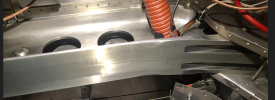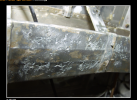Have been doing a little research on these. Seems originally, they had some handling issues that were corrected by Cessna. Asking prices on these are appear to be lower than a similar hours/equipped 172. Are they more expensive to own or have other problems? Guess what I am asking is there anything that would make buying one a mistake? Looking at 180HP models.
You are using an out of date browser. It may not display this or other websites correctly.
You should upgrade or use an alternative browser.
You should upgrade or use an alternative browser.
Cessna 177
- Thread starter fast99
- Start date
RyanShort1
Final Approach
There's a big wing spar AD that is affecting all of them at the moment. Anything you want to know can be found here:


RyanShort1
Final Approach
The Cardinal Spar is a pretty substantial thing, but after some corrosion and mistreatment of some spars overseas, they decided to look at the entire fleet. The grounding numbers don't seem to be too bad, but there are some very unhappy owners at the moment who's planes did fail the inspections.Thanks, sounds like the similar issue effecting some Pipers.
The Cardinal Spar is a pretty substantial thing, but after some corrosion and mistreatment of some spars overseas, they decided to look at the entire fleet. The grounding numbers don't seem to be too bad, but there are some very unhappy owners at the moment who's planes did fail the inspections.
I looked at Cardinals, a long time ago. It seems that the spar carry-through was the critical component. If it was corroded, you had a paper weight with wings. Unless your bank account was very substantial....
-Skip
My annual is due next month. I'll let you know how painful the AD is.The Cardinal Spar is a pretty substantial thing, but after some corrosion and mistreatment of some spars overseas, they decided to look at the entire fleet. The grounding numbers don't seem to be too bad, but there are some very unhappy owners at the moment who's planes did fail the inspections.
There are some odd things here and there, but I don't think it has been much of a maintenance hog. I would be surprised if the asking is lower than a similar 172 of the same vintage and engine hours. The 177s generally out-perform the 172s, particularly if you are talking about a 177B, which has the 180HP engine with constant speed prop. They are certainly more roomy inside, too. The original 177 did not have the 180 HP engine, which had a reputation for poor climb performance. If you look at Cardinal Flyers online, you will see information that suggests some of the poor climb performance was due to pilots attempting to fly by 172 book numbers rather than the book numbers for the 177. But I have never flown one of those.Have been doing a little research on these. Seems originally, they had some handling issues that were corrected by Cessna. Asking prices on these are appear to be lower than a similar hours/equipped 172. Are they more expensive to own or have other problems? Guess what I am asking is there anything that would make buying one a mistake? Looking at 180HP models.
I have had an interest in a 177B for probably 10 years now, and have really enjoyed it. I don't think it would be a mistake if it fits your needs and the AD discussed above checks out.
Dan Thomas
Touchdown! Greaser!
- Joined
- Jun 16, 2008
- Messages
- 11,360
- Display Name
Display name:
Dan Thomas
I spent more than 40 hours removing the entire interior of a 177, then blending out many corrosion spots and pits. I had to draw grids of 1/4" squares on all affected areas of that spar carrythrough. Then an NDI tech came with his ultrasonic thickness measuring equipment and read out the thickness in every square, hundreds of them, which I recorded on photographs of these areas. Those were sent to Cessna, whose engineers evaluated it and passed it. Then I had to use the primer specified by Cessna on the carrythrough; that alone takes a lot of time to mask off the whole interior to prevent overspray onto the windows and instruments before spraying. Then reassemble everything.
Well over $40K for all that, on a $70K? airplane. There are no new carrythroughs available.
Beware.
Well over $40K for all that, on a $70K? airplane. There are no new carrythroughs available.
Beware.
Dan Thomas
Touchdown! Greaser!
- Joined
- Jun 16, 2008
- Messages
- 11,360
- Display Name
Display name:
Dan Thomas
I flew one. Anemic, it was. And it was only six years old at the time.If you look at Cardinal Flyers online, you will see information that suggests some of the poor climb performance was due to pilots attempting to fly by 172 book numbers rather than the book numbers for the 177. But I have never flown one of those.
I spent more than 40 hours removing the entire interior of a 177, then blending out many corrosion spots and pits. I had to draw grids of 1/4" squares on all affected areas of that spar carrythrough. Then an NDI tech came with his ultrasonic thickness measuring equipment and read out the thickness in every square, hundreds of them, which I recorded on photographs of these areas. Those were sent to Cessna, whose engineers evaluated it and passed it. Then I had to use the primer specified by Cessna on the carrythrough; that alone takes a lot of time to mask off the whole interior to prevent overspray onto the windows and instruments before spraying. Then reassemble everything.
Well over $40K for all that, on a $70K? airplane. There are no new carrythroughs available.
Beware.
Is that because the spar failed the inspection, or was that just to complete the inspection?
Dan Thomas
Touchdown! Greaser!
- Joined
- Jun 16, 2008
- Messages
- 11,360
- Display Name
Display name:
Dan Thomas
This is maybe seven years ago. It had corrosion. I found it during a prebuy, knowing that these things were famous for corrosion. That carrythrough is in the ceiling, and the moisture from the breath of the aircraft's occupants condenses in there. Adding to the mess are the CAT hoses for the vent system. They chafe on that carrythrough and the steel wire in the hose ends up against the aluminum, and so we get electrolysis too. The carrythroughs were never primed at the factory.Is that because the spar failed the inspection, or was that just to complete the inspection?
Cessna's engineers never figured that their creations would be flying 50 and 60 and 70 years after production. Nor was litigation such a big threat back then. They might have built the airplanes differently if they had known.
bnt83
Final Approach
RyanShort1
Final Approach
Already done three for our company planes.My annual is due next month. I'll let you know how painful the AD is. We’ve done two of them already
Dan Thomas
Touchdown! Greaser!
- Joined
- Jun 16, 2008
- Messages
- 11,360
- Display Name
Display name:
Dan Thomas
Yeah, that one's a killer. Amazing it got this far. I'd bet that the rest of the airframe isn't much better.Well.. some of the same _________ that have been ignoring any sort of preventative action for 30+ years are now being tasked to actually look.
View attachment 122407
Getting a look at that spar is difficult, takes lots of time and effort to get the headliners out, front and rear. So it gets ignored.
From FAR 43 Appendix D, the minimum required for an annual or 100-hour inspection:
(f) Each person performing an annual or 100-hour inspection shall inspect (where applicable) all components of the wing and center section assembly for poor general condition, fabric or skin deterioration, distortion, evidence of failure, and insecurity of attachment.
So how many annuals did that spar go through before someone either looked at it or flagged it??
Given this occurs in the center of the wing spar, I presume you lose both wings. Not sure that makes recovery easier. But I'll defer to the experts on that.Thanks for the information. Now I know what to look for. Kind of surprising people are risking their life not doing proper maintenance or inspection. Hard to pull out of a problem with 1 wing.
Dan Thomas
Touchdown! Greaser!
- Joined
- Jun 16, 2008
- Messages
- 11,360
- Display Name
Display name:
Dan Thomas
You could lose one. The other would spiral the fuselage down to the crash.Given this occurs in the center of the wing spar, I presume you lose both wings.
Nice. Saves the NTSB the trouble of searching for it.You could lose one. The other would spiral the fuselage down to the crash.
- Joined
- May 11, 2010
- Messages
- 20,703
- Location
- Charlotte, NC
- Display Name
Display name:
Snorting his way across the USA
Would that be a 'Cardinal sin?'Thanks for the information. Now I know what to look for. Kind of surprising people are risking their life not doing proper maintenance or inspection. Hard to pull out of a problem with 1 wing.
Ashara Keliyn
Pre-takeoff checklist
- Joined
- Feb 20, 2023
- Messages
- 132
- Display Name
Display name:
Ashara
I wonder what would it take to get a PMA to manufacture these spars?
Dan Thomas
Touchdown! Greaser!
- Joined
- Jun 16, 2008
- Messages
- 11,360
- Display Name
Display name:
Dan Thomas
More than it's worth. The original part was forged and machined. Forging is expensive, especially for tiny production runs, and most attempts would involve machining the whole thing from a billet. That would require extensive design and testing to make sure a machined part was at least as strong as the forged part. Since there is only so much room to fit this thing into the fuselage and to the wings, that gets tough. You can't just make it bigger or thicker or fatter. All you could do is make it from something like titanium, and that would be obscenely expensive.I wonder what would it take to get a PMA to manufacture these spars?
Last edited:
Cardinalguy
Pre-Flight
I paid $500 for the inspection, passed with flying colors.
Ashara Keliyn
Pre-takeoff checklist
- Joined
- Feb 20, 2023
- Messages
- 132
- Display Name
Display name:
Ashara
Thank you, great explanation!More than it's worth. The original part was forged and machined. Forging is expensive, especially for tiny production runs, and most attempts would involve machining the whole thing from a billet. That would require extensive design and testing to make sure a machined part was at least as strong as the forged part. Since there is only so much room to fit this thing into the fuselage and to the wings, that gets tough. You can't just make it bigger or thicker or fatter. All you could do is make it from something like titanium, and that would be obscenely expensive.


